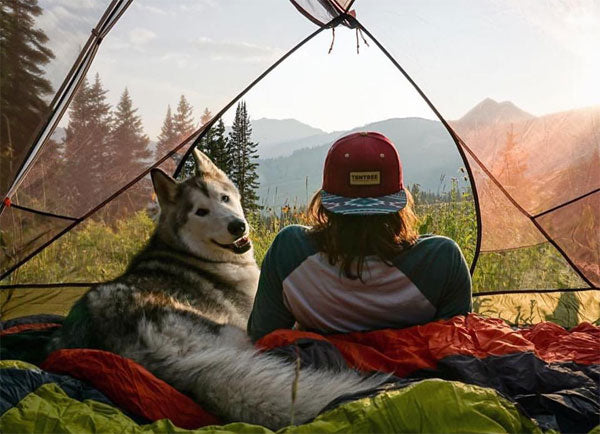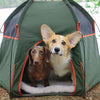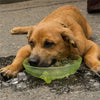Social Distance Camping With Your Pets
Posted by Michael Shine
Camping describes a range of activities and approaches to outdoor accommodation. Survivalist campers set off with as little as possible to get by, whereas recreational vehicle travelers arrive equipped with their electricity, heat, and patio furniture.
Camping may be combined with hiking, as in backpacking, and often enjoyed in conjunction with other outdoor activities such as canoeing, climbing, fishing, and hunting. Fastpacking involves both running and camping.
When going camping with your pets for the first time, start with an overnight campout and keep it simple:
- To save money, borrow or rent big-ticket gear.
- To maximize your comfort, always bring appropriate clothes for cold and rain.
- To satisfy your fresh-air-fueled hunger, bring plenty of food.
- To keep your options open, camp close to home. (There's no shame in bailing if problems arise.)
- To ensure you get an excellent first impression, postpone your campout if the weather forecast is awful.
- To be sure you leave a good feeling for those who come after you, make sure you follow Leave No Trace principles.
You can keep your initial investment low if you borrow or rent the priciest items. The tent, sleeping bags, and sleeping pads are useful items to get from a friend if you can for your first adventure.
That's a better strategy than paying bottom dollar for something that might not last for a single camping trip. If you are ready to invest in your very own camping gear, here are a few tips to help you decide what to buy.
- First Aid Kit: A well-stocked first aid kit is a handy thing to have. First aid kits come in many shapes and sizes.
- Dome Tents: The least expensive tents tend to be heavier, less durable, and less waterproof. The most costly tents, used by backpackers and professional adventurers, are usually lighter in weight, more durable, and more waterproof.
- Camp Stove: A cooking stove specially designed to be portable and lightweight, used in camping, picnicking, backpacking, or other use in remote locations where an easily transportable means of cooking or heating is needed.
- Sleeping Bag: An insulated covering for a person, mostly a lightweight quilt that can be closed with a zipper or similar means to form a tube, which functions as thin, portable bedding. In situations where a person is sleeping outdoors (e.g., when camping, hiking, hill walking, or climbing). Its primary purpose is to provide warmth and thermal insulation through its synthetic or down insulation.
- Air Mattresses or Sleeping Pads: The deflated mattress can be rolled up or folded and carried or stored relatively quickly, making them a popular choice for camping trips and temporary bedding at home for guests. They are inflated either orally by blowing into a valve, or with a manual foot-powered or more commonly inflated via an electric pump. Some are even automatically raising just by opening the valve.
- Lighting: Light up the night with flashlights, headlamps, lanterns, spotlights, or tactical lights. Whether it's to get extra light at the campsite or come to the rescue during a power outage, using a lamp or flashlight will always come in handy.
- Cooler: When considering an outdoor beverage cooler, there are a few considerations you need to make. Will this need to be a cooler with wheels or strictly a patio cooler? Maybe you want a cooler with speakers to listen to your tunes while entertaining guests.
- Utensils: The basics, try to use nonplastic materials or items that can be cleaned and reused. Always practice removing whatever you bring in with you and try not to leave a trace. Bring a new set of dog bowls to show off your team pride.
- Comfort Items: Your special blanket, music devices, and whatever else you can jam in your vehicle will make it feel just a little more like home. Your pet's favorite bed or pillow will make everything feel more comfortable.
Now it's time to get outdoors and setting up camp. Your camping supplies are in your vehicle, you followed our tips above, and you are ready to get car camping. But where?
Glad you asked, There is no shortage of camping locations in the National Park Service -- there are over 130 park units to choose! Use the map here to find a park with camping opportunities. Each site will link you directly to that park's website.
Ok, the car is ready, we found a place, and it's finally time to go. Leave early, so you can get to your site scope out the land and find your perfect spot. Unfortunately, the first step includes cleaning; we waited until now to bring it up so you wouldn't get discouraged.
We aren't saying start washing your car and doing the windows, but instead cleaning up your exact spot, you will be camping. Start by gathering up all the rocks that you could use to create a fire pit and pile them where you will eventually build a fire.
You will want to continue cleaning with large branches and long pieces of kindling. Pile these resources alongside your fire pit for easy access when you begin starting a fire. Don't forget to look all around your fire pit high and low for any possible items that can quickly catch fire and cause you problems.
Now that you cleaned up your spot gathered all the timber near your camp and it looks nice, lets set up your tent. It's a good idea when setting up your tent to check the wind's direction and will be blowing that evening. When the campfire burns, smoke will not be filling your sleeping area if you place it downwind.
Please put down your tent floor mat and build your tent over it. Install your air mattress and fill it up. You are now in decent shape, but it's going to start getting chilly, and it's not camping unless you have a campfire.
Building the campfire is not as hard as it sounds. Please start with the rocks you gathered, making sure to pick a beautiful clearing not to close to your newly built tent, but close enough that you don't need your hiking gear to get to it. Take the rocks and create a fair size circle on the ground about a car tire's size. Stack the stones up to make a wall that will contain your fire.
You can take some firestarter, dryer lint, or tiny twigs called tinder. Pile this material into a pyramid shape, starting with the smaller pieces first than gradually increasing your twigs until you have a little Christmas tree shape. Now its time to take the larger pieces and build around your new structure.
Start stacking the larger branches into an excellent shape but not too large. You are now ready to light the fuel and enjoy the fire. Continue to look around your site and clean up the branches and debris by burning it in your newly constructed fire.
The final part and most enjoyable would be the adventures you find and share with the people and pets you are camping. Go fishing, hiking, or sit on a rock and enjoy the outdoors. We hope our guide will help you get out and enjoy the beauty we have right out our door.
 5 Star Customer Reviews
5 Star Customer Reviews FREE Shipping Over $39
FREE Shipping Over $39
 Exceptional Customer Care
Exceptional Customer Care





